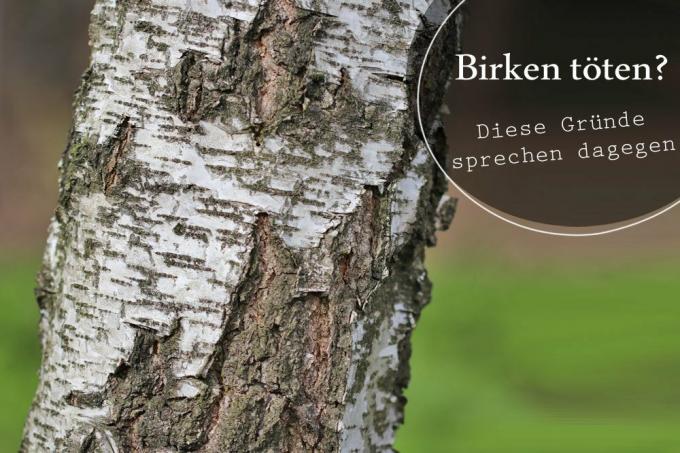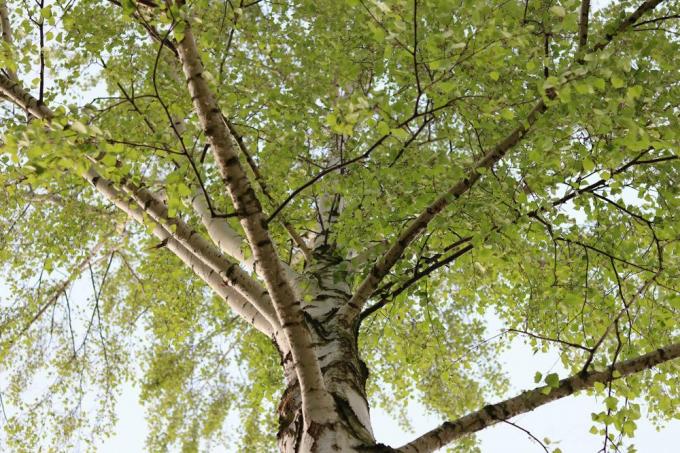
table of contents
- Killing birches
- Killing reasons against birch trees
- Creates living space
- Improves site conditions
- Embellishes landscapes
- Provides healthy food
- Suitable for everyday objects
- Deadwood
- Why you want to kill birch trees
- Climate change is killing birch trees
- What allergy sufferers can do
The birch does not have a good reputation. Allergy sufferers in particular are annoyed by the amount of annoying pollen in the spring. Many people affected therefore wonder what kills the birch. But such plans are highly nonsensical. Anyone who kills a birch risks nasty consequences. This is a plea against attempted killing.
Killing birches
The birch is not prepared for very specific environmental influences. Trees die when their location no longer offers optimal conditions. Humans can also use targeted methods that slowly kill the tree.
Wet feet
When winters are too warm, precipitation falls as rain. Rivers and lakes are flooded. Heavy rains after extended dry periods in summer also cause flooding because the water can no longer seep into the heavily compacted soils. Waterlogging occurs, which causes problems for the Betula roots. It is becoming increasingly susceptible to pathogens and pests. Weak trees do not tolerate extreme environmental influences as well.
Drought stress
The groundwater level sinks to a minimum after weeks of heat waves, so that the roots of the birch trees can no longer absorb water. They are weakened and can no longer grow. Reserves are slowly running out, because the lack of water means that the deciduous trees cannot absorb or store nutrients from the soil. Drought stress occurs, which causes various phenomena:
- Insect calamities
- early leaf discoloration
- Leaf fall
- Frost damage
- Tree dieback after repeated emergence
Curling
In the lower part of the trunk, a strip of bark about ten centimeters wide is peeled off. If the cambium below is removed with the bark, the tree can hardly close these wounds. Consequently, the flow of sap is interrupted with the assimilates achieved by photosynthesis. These substances flow from the leaves into the roots and guarantee its function. However, the transport of water and nutrients to the leaves is preserved, as this takes place in the deeper layers. The consequences of this method cause the tree to die in twelve to 36 months:
- insufficient nutrient supply kills roots
- Leaves change color and fall off
- Briefly increased semen production, which means that additional energy is lost
Excessive tapping
If a hole is drilled in the trunk, large quantities of birch sap will leak out of the wound within a few hours. Strong and healthy trees regenerate quickly from the loss, provided the hole is tightly sealed. If this is not the case, the wound will not be able to close properly and the birch will constantly lose sap. This continuous loss kills the tree. However, if the wood is tapped every year, deficiency symptoms occur, which slowly kill the tree. It lacks important substances for the development of new flowers, leaves and roots.
Note: This method, like other measures, should not be used specifically to kill an annoying tree! Such rash practices can result in criminal penalties.
Killing reasons against birch trees
The birch is a special tree that has innumerable advantages for animals and humans. Only one tree ensures that specialized species find enough food and retreats in their entire life. Humans can use flowers, leaves, buds and even the bark. Even after it dies, the tree is not worthless. The following reasons are a plea against the thoughtless killing of birch trees.
Creates living space
Birch trees are one of the most popular trees in the insect world. They serve as a source of food, breeding ground and retreat. After willows and oaks, Betula species are the most heavily populated tree species in Central Europe. Birch trees are approached by various butterflies that sunbathe on the leaves and lay their eggs there. This diversity of insects attracts numerous birds that feed on the insects. The tree itself also provides food for the bird world. Black grouse, hazel grouse, capercaillie and grouse eat the buds and catkins of the deciduous trees. Some siskins have a bond with birch trees. Arctic siskin, siskin and siskin like to peck the kittens.
- more than 160 species of insects
- approx. 120 species of large butterflies
- over 30 species of birds
Improves site conditions
Birch trees are pioneer trees that grow first on barren sites and fresh fallow land. The deciduous tree does not make any special demands on the soil. Betula species even get along well in the blazing sun. They are true all-rounders because they can cope with a wide variety of environmental conditions. Late frosts do not cause the cold-resistant tree any problems. The birch is a valuable tree for reforestation and for closing the edge of the forest. In the course of the almost 120-year lifespan of a birch, other tree species can assert themselves in the originally suboptimal location. There are many reasons:
- enriches humus
- light crown ensures partially shaded conditions
- protects slope soils from erosion and consolidates them
Embellishes landscapes
The native birch species include the silver birch (Betula pendula) and the downy birch (Betula pubescens). They belong to the tree species that significantly improve the aesthetics of an environment. The black and white color of the bark in combination with the light green leaves are what make these unique trees so attractive. The appearance of these deciduous trees changes depending on the site conditions. They appear predominantly tree-shaped in Central Europe. The further north they occur, the more shrubby they grow. Therefore, Betula species are popular trees in landscaping.
Provides healthy food
To this day, different parts of the birch are used as food. Birch sap provides a refreshing cooling off in spring. It can be boiled down to make syrup and used for brewing beer. Today, sugar is obtained from birch sap. This birch sugar represents an alternative to beet sugar and is at the same time less harmful to the teeth, because the juice has a caries-inhibiting effect. At the end of winter, the buds can be harvested and added to salads. Below the outer bark there is a reddish layer that can be dried and made into flour. This flour is suitable for making bread, baked goods or pasta. The birch also helps with various diseases:
- Birch sap strengthens the immune system with vitamin C and minerals
- helps against rheumatic complaints
- Leaf tea works against bacterial inflammation of the urinary tract
Suitable for everyday objects
Birch bark is still an important raw material for the manufacture of various everyday objects in Nordic countries. The idea of storage containers for tea, flour and bread comes from Siberia. Such containers are conquering the European market because they are environmentally friendly, ecological and at the same time valuable. Bread stays fresh and mold-free longer because the rind contains betulin. This substance has antiseptic properties. Birch bark is therefore also suitable for preserving food.
Deadwood
Even if the life of a birch tree naturally comes to an end, life is not over. Deadwood is one of the components of nature that is becoming increasingly rare. But it is precisely here that a species-rich world is developing, with some highly specialized species. The dead wood continues to offer a valuable habitat for numerous animal, plant and mushroom species. Lichen settles on the bark, some species of which can be used as indicators for particularly clean air. Numerous insects such as beetles and bugs find a safe haven in the rotten wood. Some larvae such as the useful fire beetles (Pyrochroidae) are dependent on the moist microclimate in the wooden corridors.
Why you want to kill birch trees
Many people suffer from a pollen allergy. Birch pollen is one of the strongest allergens that cause immune system reactions after inhalation. It is not uncommon for those affected to look for a quick solution to the problem that kills the annoying pollen producer in front of the house. The fact is, however, that the amount of pollen changes from year to year and is not consistently high. Not only the birch trees are to blame for the suffering of many people, but numerous other tree species spread pollen in spring. Even if the birch has been removed in front of the house, the allergy can continue to show because pollen spreads through the air and can travel long distances.
Climate change is killing birch trees
The birch is already having a hard enough time with the ever more frequent extreme events. Suboptimal environmental conditions occur in combination. After the winter months that are too wet, the summer drought comes, which is interrupted by torrential rains. Birch trees can no longer cope with these phenomena. Birch trees can be observed more and more often on roadsides and avenues or in parks, the leaves of which have dried up completely in summer and fall off.
What allergy sufferers can do
There are numerous tips that should alleviate the symptoms. This includes changing clothes after a walk, airing out during the night, washing your hair and rinsing your nose. The only thing that really helps against an allergy is desensitization. Here, allergens are administered to the person affected in increasing doses so that the body can get used to them. Drinking birch sap regularly is said to have already helped many allergy sufferers. The symptoms have decreased significantly or at least have not worsened. Feel your way around carefully and taste small amounts for the time being to determine possible side effects. If the juice is good for you, you can slowly increase the amount.
tip: If you want to draw birch sap from forest trees yourself, you should ask the forest owner for permission beforehand. Because careless measures will kill the tree, you should proceed with the utmost care.






